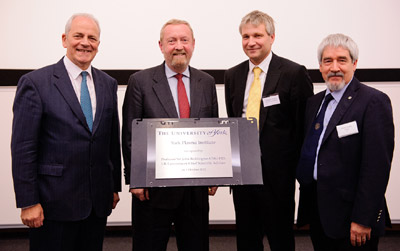New vision for plasma research to open in York
A world-class interdisciplinary plasma research centre, designed to foster collaborations between industry and universities, has been officially opened at the University of York.

The York Plasma Institute (YPI), the result of a £6m collaboration between the University and the UK Engineering and Physical Sciences Research Council (EPSRC), was opened by the Government’s Chief Scientific Adviser, Professor Sir John Beddington, on Monday, 1 October.
Part of the Department of Physics, the Institute represents a capital investment of £3.7m and provides facilities for research and training in fusion energy; low temperature plasmas for technological and biomedical applications; and laser-plasma interaction.
Plasma is a form of ionised gas, and is abundant in the Universe – stars, including the Sun, are in a plasma state, as is the solar wind, the Northern Lights and lightning. Plasma can be relatively cool, such as in a modern television set or a fluorescent light bulb, or extremely hot, such as in the core of the Sun.
The York Plasma Institute brings together high temperature plasmas for fusion and laser-plasma interaction research with low temperature plasmas under one roof, enabling synergies between the disciplines to be exploited.
Vice-Chancellor of the University of York, Professor Brian Cantor, said: “Our vision is to establish a world-leading interdisciplinary plasma physics research and training institute. We want to inspire partnerships between industry and universities and encourage start-up companies, maximising the value of the research and its impact on society.”
Professor David Delpy, Chief Executive of EPSRC, said: “To drive forward high quality research requires world-leading facilities and EPSRC is pleased to be able to partner with York to build on their already strong track record in this field.”
On Earth, plasmas are usually man-made. These span from relatively cool plasmas used in industry, such as low energy light bulbs, plasma displays or for biomedical applications, to those heated to ten times the temperature at the centre of the Sun, which are used in the quest for fusion energy.
If the scientific and technological challenges can be overcome, fusion offers the potential for an effectively limitless supply of safe, environmentally friendly energy. To address these challenges, University of York researchers collaborate closely with the national fusion programme at Culham Centre for Fusion Energy (CCFE) and the Science and Technology Facilities Council’s (STFC) Rutherford Appleton Laboratory, Oxfordshire, as well as other international fusion laboratories.
We want to inspire partnerships between industry and universities and encourage start-up companies, maximising the value of the research and its impact on society
Professor Brian Cantor, Vice-Chancellor
York Plasma Institute Director, Professor Howard Wilson, said: “With the construction of the international fusion facility ITER, the largest international science project on Earth, fusion is entering an exciting new era.
“It takes fusion beyond a scientific study, requiring closer collaboration between scientists, engineers and industry to address the remaining scientific and technological questions and deliver energy to the grid. The philosophy of the York Plasma Institute embraces this collaborative approach: it is a really exciting time for us.”
The new facilities of the York Plasma Institute house 11 academic staff, 10 post-doctoral researchers and over 40 postgraduate students.
The main YPI building includes the Remote Tokamak Control Room which enables remote participation and leadership of some experiments on the MAST tokamak at Culham Centre for Fusion Energy, as well as experiments on other tokamaks world-wide, such as the new superconducting tokamak KSTAR in South Korea. In addition, there are postgraduate teaching facilities and video-conference meeting rooms.
Separate purpose-built laboratories at the York Plasma Institute provide a valuable environment for experimental facilities for industrial and academic collaboration. These include a laser laboratory used, for example, to simulate astrophysical plasma phenomena, and a biomedical laboratory for investigating potential biomedical applications of low temperature plasmas, including sterilisation, wound healing and cancer treatment. A plasma processing laboratory with equipment donated by Intel allows researchers to study and optimise the plasma processes used in computer chip manufacture.
The opening event featured a series of workshops, keynote speakers, tours of the facilities, display posters, networking opportunities and outreach sessions for local schoolchildren. The day of activities culminated with the official opening and keynote speech by Professor Sir John Beddington.
Further information
